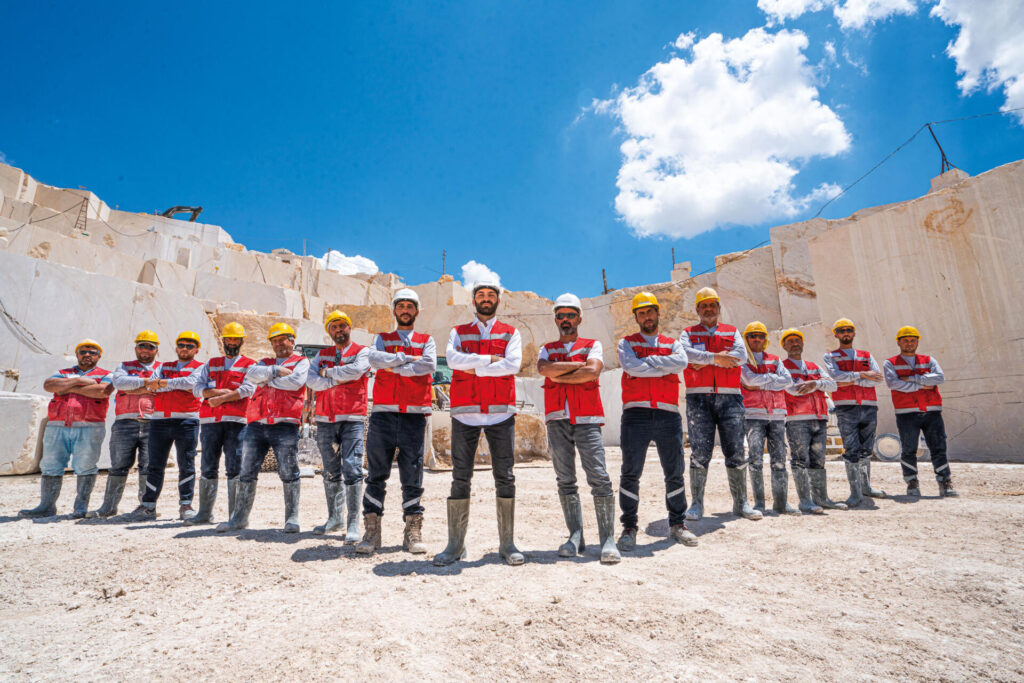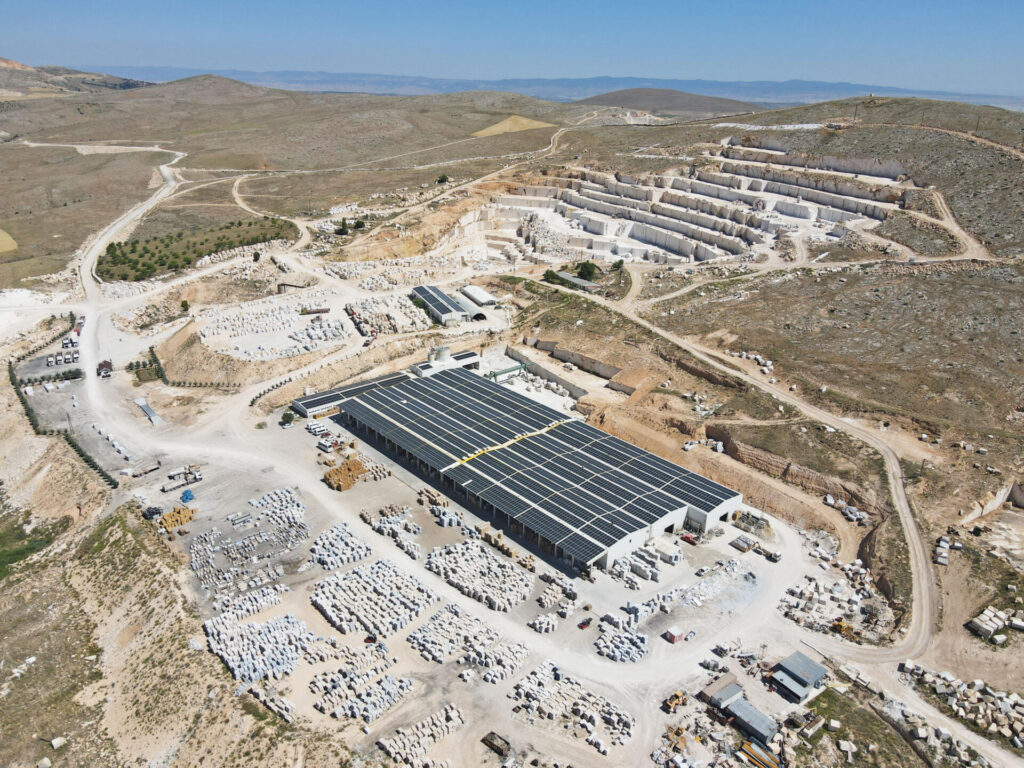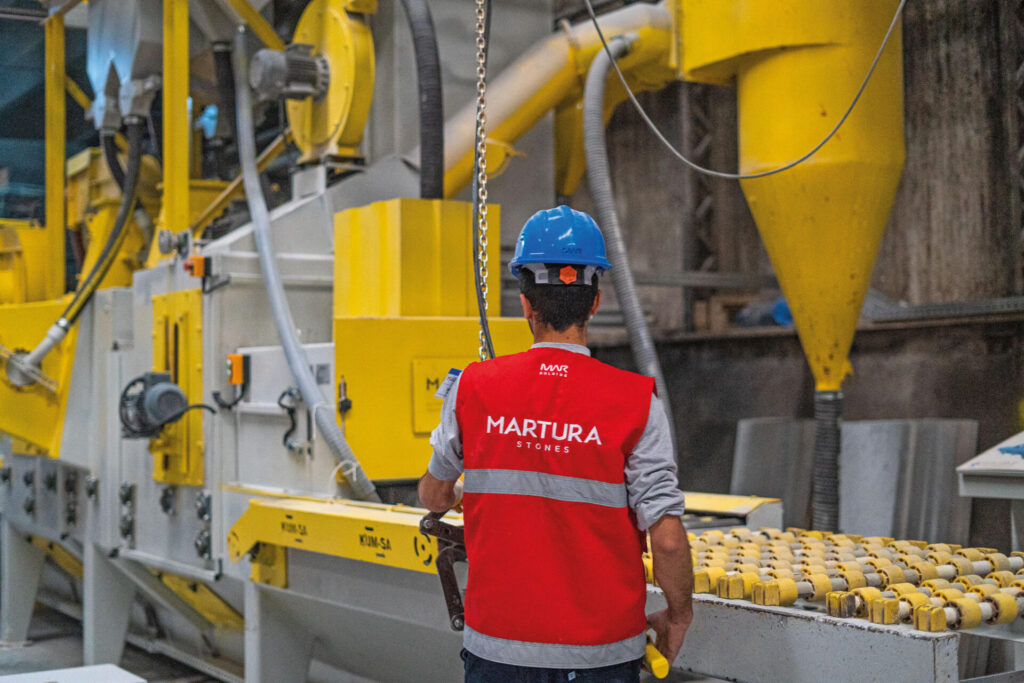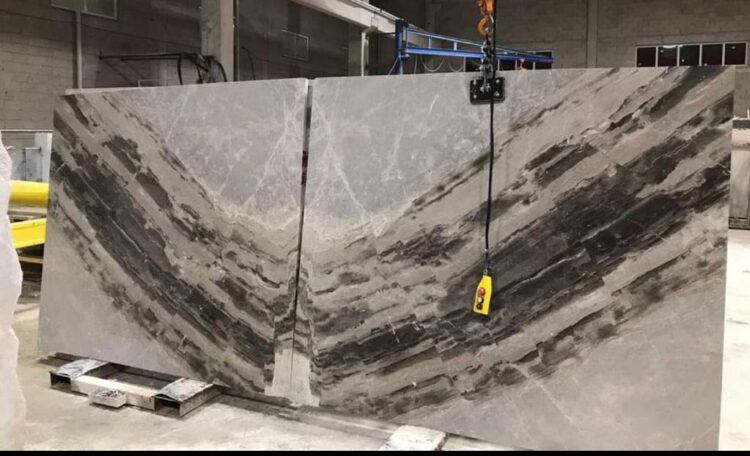Big accidents starts with minor negligence.
Let’s follow the occupational safety rules in order not to regret.
Occupational health and safety is a severe concept as one of the most critical issues in our lives. Occupational health and safety awareness in our country has increased recently, and activities in this field have accelerated. In this interview, we will learn about the regulations and activities on occupational health and safety. Funda Bekişoğlu, Chairman of the Board of Martura Stones Company, who sees occupational health and safety issues as a part of the production and the system, answered the questions of Turkish Stone World Magazine.

Funda Bekişoğlu is one of the leading names in the marble industry. Having graduated from METU Electrical and Electronics Engineering and Business Administration, Bekişoğlu worked as a system and project manager at Koç Holding and then took on the duties of finance coordinator and vice chairman of the board of directors at the family company Turan Bekişoğlu Marble Inc. Co. At the same time, Martura Stones Foreign Trade Inc. and Marmiro Stones Companies, Bekişoğlu aims to contribute to social life and human development by taking part in various foundations, non-governmental organizations and social responsibility projects besides her business life. We talked to her about her experiences, successes, occupational health, and safety in the marble sector. Taking an active role in sectoral organizations such as IMIB and TUMMER, Bekişoğlu contributes to the development of the marble industry and adds value to Turkey’s exports.
Could you briefly tell us about occupational health and safety?
In recent years, in parallel with the increase in Occupational Health and Safety awareness in our country, the activities carried out in this context are gaining momentum. The main reasons for this are the increasing costs caused by the loss of labor and time due to the growing number of work accidents and their harm to the employer and the country’s economy.
Of course, official inspections and administrative fines also compelled workplaces to take the necessary measures regarding Occupational Health and Safety and to increase awareness. While most workplaces now see Occupational Health and Safety issues as a part of the production and the system, some workplaces, unfortunately, continue to see it as a waste of cost and time.

Can you evaluate the occupational health and safety studies in our country?
Training, publications, conferences, etc., of the Occupational Health and Safety culture are given to employees, employers, and briefly to all stakeholders. It will be beneficial in terms of creating a safer and healthier working environment. Giving Occupational Health and Safety as one of the introductory courses in schools will increase awareness starting from the basic education level.
The legal responsibility of employers is heavy. what are the ohs responsibilities of occupational safety specialists and employees?
Employers get help from Occupational Safety Experts. The legislator has determined the obligations of occupational safety experts and held them as responsible as the employer.
Duties of occupational safety specialist;
- Guidance
- Risk assessment
- Work Environment Surveillance
- Education, Information, Registration
- Cooperation with Relevant Units
Occupational safety specialist obligations;
- Occupational Safety Specialists, while performing their duties specified in the regulation, are responsible for not disrupting the normal flow of work as much as possible, contributing to the provision of an efficient working environment, and keeping information about the employer’s and workplaces professional secrets, economic and commercial situations confidential.
- Occupational Safety Specialists are responsible to the employer they provide services for their negligence in the execution of Occupational Health and Safety services.
- The Occupational Safety Specialist, in case the employer does not fulfill the measures to be taken regarding Occupational Health and Safety in writing, which are life-threatening, such as fire, explosion, collapse, or chemical leakage, in case the employer not fulfilled. They must notify the Provincial Directorate of Labor and Employment Agency in writing.
- The Occupational Safety Specialist must write down the findings and recommendations regarding the work done in the workplace where he is assigned, the job done together with the Workplace Physician, and other matters he deems necessary in the approved book.
Occupational Health and Safety is a subject defined by law (Law No. 6331), and it is a situation that binds employees and employers.

Obligations of employees
- Correctly using and not changing the machinery, devices, tools, equipment, dangerous goods, transport equipment, and other production tools and their safety equipment in the workplace,
- Not to endanger themselves and other colleagues,
- Participating in Occupational Health and Safety training, complying with the relevant instructions,
- Using and maintaining the personal protective equipment given to them,
- Not to damage the machines and equipment they work with,
- Notifying their supervisors and employee representatives when they encounter a severe and imminent danger; responsibilities are determined by law.

What are the most difficult points in occupational health and safety practices?
Although there are instructions, there are always difficulties in terms of applicability in workplaces. For example, the low level of education of the working personnel and, accordingly, their disregard for the dangers, indifference, not taking the threat seriously, and inattention arising from the self-confidence of the experienced personnel cause difficulties in implementing the Occupational Health and Safety rules. In our country, heavy working conditions in some workplaces, life conditions outside of work, and psychological problems can be shown among the issues that directly affect Occupational Health and Safety.
When we consider all these components, there may be situations where we need help enforcing Occupational Health and Safety rules from time to time. In such cases, we try to solve such problems by talking to the personnel about the situation, giving training, and making examples.
There are also judicial decisions taken for employers. The most important and binding one among them is “The employer is obliged to take not only the measures required by the legislation in the workplace but also the measures stipulated by today’s science and technology within the framework of respect for human life, which should be sanctified. Employees’ safety cannot be left to their ATTENTION…” Therefore, the employer should take, implement and follow all the necessary measures in terms of OHS for its employees.
Martura Stones;
Being aware of the above, it is our priority to take all the measures that must be taken by the Occupational Health and Safety Law No. 6331 and related regulations within the scope of a hazardous workplace.
In this context, workplace-specific procedures define Annual Periodic Health Checks, Training, Risk Analysis, Emergency Plans, Exercises, Periodic Tests, and Measurements and do what is necessary. We ensure the participation of all stakeholders (employees, employers, Occupational Safety Specialists, Workplace Physicians, Subcontractors, if any, etc.) in the preparation process. After these procedures are established, they are followed up periodically, additional risks are evaluated, necessary revisions are made, and precautions are taken.
Other than these procedures, when business-specific hazards and risks are determined during field inspections and necessary precautions are taken.

What are the precautions you take at the quarry and factory at martura stones company?
General Precautions
- It is ensured that all personnel have vocational training certificates.
- All personnel start working after receiving training for the machines and equipment to be used.
- If the operators will be operating a forklift, crane, digger, truck, excavator, etc. machine, the work is started after the relevant license or certificates are checked.
- All personnel start to work after the On-Site Physician examines their health reports and if the phrase SUITABLE is received.
- Each machine has an operating instruction, and information on occupational safety rules is communicated to the employees with these instructions.
- Basic OHS Training and Work at Height Training are given periodically to all personnel.
- Training on using Personal Protective Equipment is given to all personnel periodically.
- Helmets, ear protectors, steel-toed boots, work clothes, work shoes, and glasses are delivered to all personnel according to their work, and their use is inspected during field controls.
- Training videos about safety precautions and accidents are published in common areas.
Measures taken in the quarries
- Employees are periodically informed about the Warning and Warning Signs in the quarry.
- Personnel entry is prevented by pulling safety ropes on the step edges.
- Unused step edges are closed with blocks to prevent personnel entry.
- It is ensured that the rest areas of the employees are located away from the edge or below the level.
- Parts at risk of slipping and falling, such as poplars, freestanding parts, and rocks, are routinely checked, and necessary precautions are taken.
- Before the wire-cutting machines are installed, the wire components are checked, and necessary adjustments are made. A damper protector is used against the risk of wire breakage.
- It is ensured that the wire-cutting machines are installed and operated so they do not target each other or the employees.
- To prevent the machines’ energy cables from contacting the ground or water, a carrier stand is provided. (Against the risks of cable crushing, electric shock, fire, etc.)
- The electrical and mechanical parts of the machines are checked periodically.
- Periodic maintenance of construction equipment such as buckets, excavators, and dump trucks is recorded.
- Bucket, excavator, and dump truck; activities such as loading, unloading, drilling, and breaking are planned to be at least 30 meters away from other personnel.
- While raw material is being loaded, o Truck or truck is positioned on flat ground.
- First, personnel place wooden wedges on the trailer according to the material size.
- Related personnel move away from this area to a point where they can direct the machine operator.
- The operator slowly releases the raw material as the pointer directs to coincide with these wedges.
- After the loading process is completed, the condition of the load is visually checked.
- The lorry or truck driver is removed from the vehicle until the whole process is completed. It is not allowed in or near the vehicle cabin.
- No chocking, chocking, or any other operation is done under the raw material in the load. In particular, operators receive much training and information on this subject.
- During the Block Tilting Process, all machinery, equipment, and unnecessary materials in this area are removed after the cutting process in the central mass is completed,
- Wedge, sand, etc., should be placed on the ground to prevent the block from falling apart and falling apart.
- All personnel are removed from this area before demolition.
- The balloon method separates the cut mass from the central mass.
- Stone pieces are thrown into the separate area with the help of heavy construction equipment, and the back-sliding of the cut mass is prevented.
- This process continues until the cut mass is completely separated from the central mass.
- All employees are kept at a safe distance during these processes.

Measures taken at the factory
- Employees are periodically informed about the warning and warning signs located in the factory.
- Against the risks of hand and foot injuries and injuries in the transportation and transfer of sized marble, Manual Lifting, and Transportation Training are provided to employees, and field applications are followed.
- Finished and semi-finished products are stacked at a maximum height of 3 meters as a precaution against the risk of tipping.
- Protective equipment is used against the risk of the plates falling over on the stand.
- In transporting heavy loads and blocks by crane, certified personnel are employed, and there are no people around or under the loads. Loads are carried at the closest level to the ground. Transport apparatus, such as slings, chains, etc., are constantly checked, and damaged ones are withdrawn from use.
- Areas, where work is done for maintenance and repair works are limited to outside interventions, and necessary warning signs are posted.
- Equipment of all machines is kept active and periodically checked.
- Training is provided for the personnel working in the epoxy furnace line, where harmful chemicals such as epoxy and acetone are used, and on the use and use of glasses, masks, and gloves. Ventilation conditions of the working area are provided, and necessary precautions are taken against possible fire and flaming risks.






























 +90 532 585 51 95
+90 532 585 51 95 +90 532 585 51 95
+90 532 585 51 95